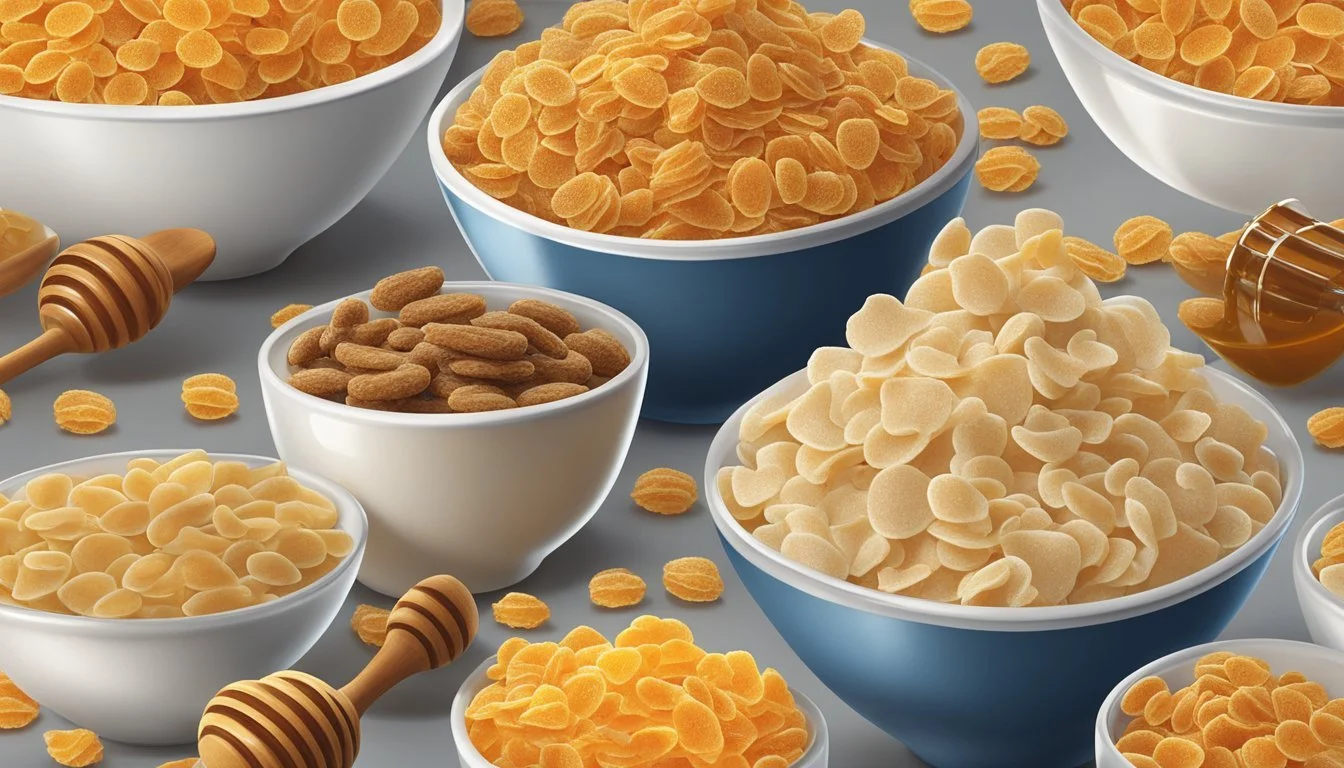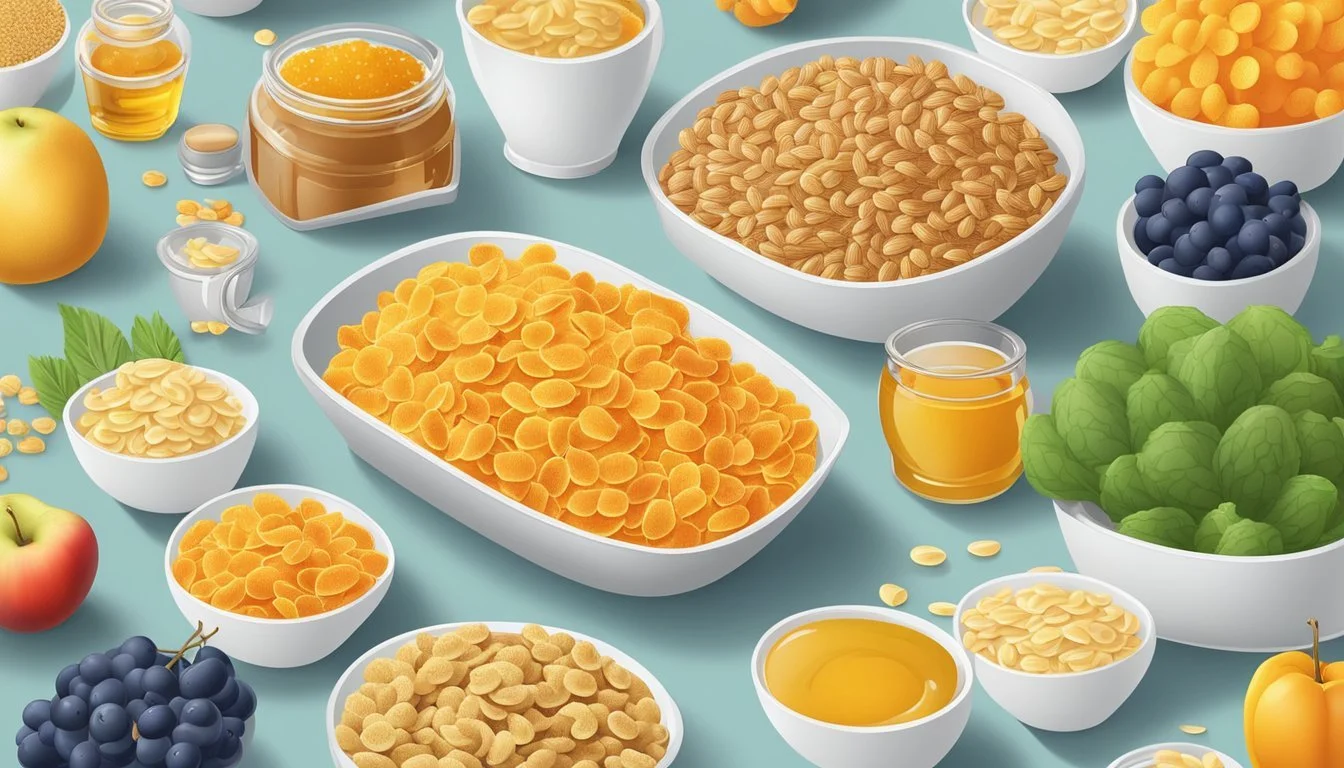Frosted Flakes vs Honey Smacks
Nutritional Comparison and Taste Test
This Article is Part of Our Breakfast Cereal Guide with Details on Frosted Flakes Nutrition and Honey Smacks Nutrition
When it comes to choosing between Kellogg's Frosted Flakes and Honey Smacks for breakfast, understanding their nutritional content is key. Frosted Flakes contain more essential vitamins and minerals like Iron, Vitamin B6, Vitamin B12, Vitamin B3, and Vitamin B1, making them a fortified option that might appeal to those looking to boost their intake of these nutrients. However, it is essential to note that Frosted Flakes are also notorious for their high sugar content, with a considerable 13 grams of sugar per serving.
On the other hand, Honey Smacks stand out with their richness in Manganese, Selenium, Phosphorus, and Copper. Despite their higher micronutrient density, Honey Smacks also pack a significant amount of sugar, contributing to their sweet flavor. Both cereals are marketed heavily towards children, but their sugar levels have made them a point of concern for health-conscious consumers.
For those prioritizing a wholesome and balanced start to their day, neither cereal emerges as a clear winner. While Frosted Flakes offer more iron and B vitamins, Honey Smacks provide other essential minerals. However, the high sugar content in both options should make any conscious consumer think twice before making them a breakfast staple.
History and Brands
Frosted Flakes and Honey Smacks are iconic cereals produced by Kellogg's, each with a rich history and significant evolutions over the decades. This section explores the origins and transformations of these beloved sugary cereals, highlighting key milestones.
Origin of Frosted Flakes
Frosted Flakes were first introduced by Kellogg's in 1952 under the name Sugar Frosted Flakes. The cereal features sugar-coated corn flakes and quickly became a favorite in American households.
The term "sugar" was dropped from its name in 1983, aligning with shifting consumer preferences towards less overtly sugary branding. Despite the name change, the recipe remained the same.
Kellogg's, the manufacturer, targets markets in the United States, Canada, and the Caribbean through WK Kellogg Co. Kellanova handles distribution for the rest of the world. Throughout the years, the mascot Tony the Tiger has been a pivotal part of the cereal's branding, emphasizing its appeal to children and adults alike.
Evolution of Honey Smacks
Honey Smacks, another cereal by Kellogg's, debuted in the 1950s as Sugar Smacks. Initially, the cereal used puffed wheat with a sugary coating, appealing to the burgeoning market for sweetened breakfast options.
In the 1980s, the name was changed from Sugar Smacks to Honey Smacks to reflect a healthier image amidst growing concerns about sugar consumption.
The cereal's mascot, Dig'em Frog, remains an iconic figure, contributing to its recognition on grocery store shelves. While maintaining its beloved flavor, Honey Smacks adjusted its branding to continue its relevance in a health-conscious market.
Ingredient Profile
Both Frosted Flakes and Honey Smacks are popular breakfast cereals produced by Kellogg's, known for their sweet taste and crisp texture. These cereals differ in their sugar content, presence of whole grains, and the types of additives and preservatives used.
Sugar Content and Types
Frosted Flakes and Honey Smacks both contain high levels of sugar, which significantly contributes to their taste. Frosted Flakes have about 11 grams of sugar per serving, mainly from added sugar in the form of sucrose. Honey Smacks, on the other hand, contain 18 grams of sugar per serving, largely from high fructose corn syrup. This difference in sugar content can influence the dietary impact and sweetness level of the cereals.
High sugar diets can pose health risks, so the choice between the two may hinge on preferences for lower sugar intake.
Presence of Whole Grains
When it comes to whole grains, neither Frosted Flakes nor Honey Smacks are strong contenders. Frosted Flakes are made primarily of milled corn, which lacks the bran and germ found in whole grains. This means they offer limited dietary fiber and fewer nutrients typically associated with whole grains.
Honey Smacks also do not boast whole grains. Instead, they rely on puffed wheat, which, while somewhat healthier than refined corn, still does not classify as a whole grain.
Additives and Preservatives
Additives and preservatives in these cereals are crucial in maintaining their shelf life and enhancing flavors. Frosted Flakes often include BHT (Butylated Hydroxytoluene) as a preservative, along with artificial colors and flavors to achieve their distinctive look and taste.
Honey Smacks also use BHT and artificial flavors, but they contain fewer artificial colors compared to Frosted Flakes. The use of high fructose corn syrup in Honey Smacks is a significant point of consideration, as it is often scrutinized for various health concerns.
These additives play a role in both the flavor profile and the long-term storage capabilities of the cereals.
Taste and Texture Analysis
Frosted Flakes and Honey Smacks offer distinct sensory experiences influenced by their composition, sweetness, and crunch. Understanding these differences can help consumers choose based on their preferences for texture and taste dynamics.
Sensory Experience of Frosted Flakes
Frosted Flakes are known for their crisp texture and sweetness. Each flake is thin and light, providing a satisfying crunch with every bite.
Upon first taste, an immediate burst of sugary sweetness is evident, which is balanced by a mild corn flavor.
The sugar coating holds up well in milk, maintaining the cereal's crunch longer than some other sugary cereals such as Cocoa Pebbles.
Although primarily sweet, they lack the additional flavor dimensions found in cereals like Cinnamon Toast Crunch, making them a straightforward choice for those who prefer a no-fuss, sweet cereal experience.
Honey Smacks' Palate Appeal
Honey Smacks, on the other hand, offer a markedly different texture and taste. The puffed wheat base gives them a light, airy texture that is less crunchy but more “chewy” than Frosted Flakes.
When it comes to flavor, Honey Smacks are richly sweet with a pronounced honey note that imparts a distinctively toasty finish. The cereal's natural grains provide a deeper, more complex taste compared to straightforward sweet cereals.
In milk, Honey Smacks absorb quickly, which can cause them to become soggy faster. Still, the initial bite is robust and flavorful, capturing a unique appeal similar to nostalgic breakfast favorites without the overpowering sweetness of other options.
Health and Diet Considerations
Both Frosted Flakes and Honey Smacks have distinct impacts on health and dietary preferences. Understanding their effects on blood sugar levels, suitability for various dietary restrictions, and overall recommendations can help make informed breakfast choices.
Impact on Blood Sugar Levels
Frosted Flakes and Honey Smacks are both sugary cereals. Frosted Flakes generally contain around 12 grams of sugar per serving, while Honey Smacks contain about 15 grams. This high sugar content can lead to rapid spikes in blood sugar levels.
For individuals monitoring their blood sugar, the presence of added sugars and limited fiber content in both cereals is a concern. Honey Smacks provide just 1 gram of fiber per serving and Frosted Flakes only marginally more. Limited fiber can mean faster digestion and quicker sugar absorption.
Dietary Restrictions and Choices
When considering dietary restrictions, neither Frosted Flakes nor Honey Smacks are particularly standout choices. Neither are organic or marketed as nutrient-dense options. Both lack substantial amounts of Omega-3s (ALA) and are generally low in protein, roughly 2 grams per serving for each.
For those looking for cereals that align with specific dietary needs such as gluten-free, vegan, or high-fiber, these cereals may not be suitable. Those seeking more nutrient-rich options are advised to look for cereals fortified with vitamins and minerals or those containing whole grains.
Recommendations for a Healthy Breakfast
For a truly healthy breakfast, options that contain more fiber and protein are highly recommended. Adding fruits or nuts to either Frosted Flakes or Honey Smacks can improve their nutritional profile by incorporating natural sources of vitamins, fiber, and healthy fats.
Considering cereals with less added sugar and more natural ingredients can also help maintain stable blood sugar levels throughout the day. Look for brands that emphasize whole grains and minimal added sugars to enhance daily nutrient intake.
Overall, while Frosted Flakes and Honey Smacks may be enjoyable, they should be consumed in moderation. For a balanced diet, integrating a variety of more nutrient-dense options ensures better sustained energy and overall health.
Market and Consumer Trends
The cereal market has seen dynamic changes in consumer preferences and consumption trends, influenced by the rise of health-conscious eating and the demand for convenient snack options.
Consumer Preferences
Consumers today are increasingly focused on nutritional content when selecting cereals. Kellogg's Frosted Flakes and Honey Smacks illustrate this trend. Frosted Flakes, with its sugary flavor, remains popular among kids' cereals, making it a common household staple. However, Honey Smacks has carved out a niche with slightly lower sodium levels and higher protein content compared to Frosted Flakes, appealing particularly to health-conscious buyers.
There's a growing interest in cereals perceived as healthier, like Honey Nut Cheerios and Frosted Mini-Wheats. These cereals tend to offer more fiber and whole grains, aligning with consumer demand for nutritious breakfast options. Despite this, the taste and brand loyalty continue to heavily influence purchasing decisions, often keeping traditional sugary cereals like Frosted Flakes in favor.
Trends in Cereal Consumption
The pattern of cereal consumption is evolving, with a noticeable shift towards snacking. Ready-to-eat cereals are no longer confined to breakfast but are increasingly consumed as snacks throughout the day. This trend is driven by busy lifestyles and the convenience these products offer.
Kellogg's has adapted to these trends by marketing their cereals, including Frosted Flakes and Honey Smacks, not just as breakfast items but also as versatile snacks. Data shows average global consumption of Frosted Flakes is around 1.04 times per year, indicating moderate but consistent demand.
In addition, market research highlights a decline in traditional cereals' popularity in restaurants, signaling a potential shift towards more innovative or health-oriented cereal options in dining establishments. With consumer preferences continuously evolving, the cereal industry's ability to adapt remains crucial for sustaining market relevance.
Conclusion
When comparing Frosted Flakes and Honey Smacks, important nutritional factors emerge.
Frosted Flakes: Each serving contains around 130 calories.
Honey Smacks: Each serving also has approximately 130 calories.
Grams of Protein per Serving:
Frosted Flakes: Contains 1 gram of protein.
Honey Smacks: Contains 2 grams of protein.
Sugary Content:
Frosted Flakes: Contains about 12 grams of sugar.
Honey Smacks: Contains 18 grams of sugar.
In terms of vitamins and minerals, Frosted Flakes contains more Iron, Vitamin B6, Vitamin B12, Vitamin B3, and Vitamin B1.
Honey Smacks, on the other hand, is richer in Manganese, Selenium, Phosphorus, and Copper. It also has significantly higher sugar content, with almost 20 grams of added sugar per serving.
While both cereals offer a quick breakfast option, the choice between them depends on individual dietary needs and preferences. Both have their unique nutritional profiles and can fit into different dietary plans.





